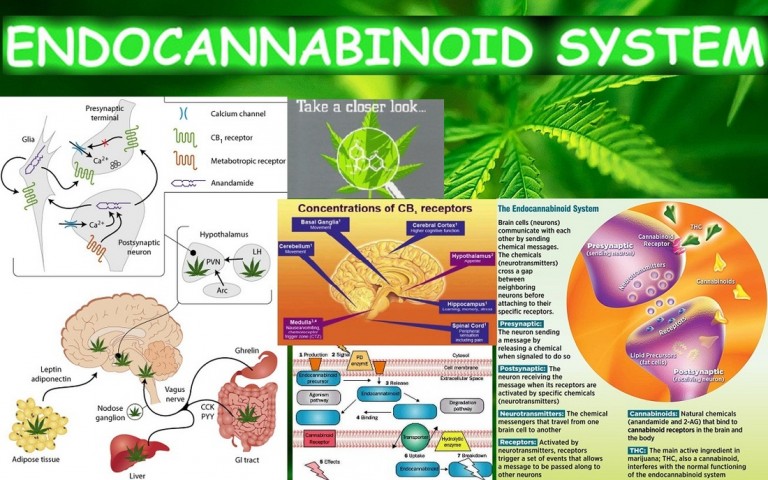Shall we smoke grass or take fish oil? Can omega-3 have the same healing effect as marijuana? Scroll down to know more about the interaction between omega-3 and the endocannabinoid system.
I’ll bet money that the first thing to pop into your head when reading that was ‘marijuana’. With the recent push for medical marijuana legalization, words like ‘cannabinoid’ and ‘endocannabinoid’ are becoming more commonly heard. It’s easy to quickly associate these terms with marijuana. The mental linking of ‘endocannabinoid’ and ‘marijuana’ is understandable. After all, the term is derived from the scientific name of the herb. However, the system and processes that these terms describe are actually naturally occurring in the body and much more complex than the effects of a single plant.
What’s the endocannabinoid system?
The endocannabinoid system was first observed in 1988 while studying the effect of cannabis sativa, more commonly known as marijuana, on rats’ brains. More scientific researches and discoveries followed, unveiling an entire system of pathways with complex interactions that have an effect on the entire body. Its most important function is keeping the body’s systems stable, regardless of external changes.
The main component of the endocannabinoid system are cannabinoid receptors. These are found within the cell membrane. It’s believed that there are more cannabinoid receptors than we currently know about, but there are two that have been extensively observed:
CB1 – This receptor is found throughout the entire body including the brain, organs, glands, connective tissue, and the immune system cells.
CB2 – While it’s found throughout the body in small amounts, it’s predominately found within the immune system cells.
These receptors send and receive signals. They’re like a postal service for the body, sending messages from cell to cell in order to initiate a particular biological process. They interact with cannabinoids, which have two main categories: phytocannabinoids and endocannabinoids. Both types have valuable health benefits, but they come from different sources and interact with the cannabinoid receptors in slightly different ways.
Phytocannabinoids
Phytocannabinoids come from plants and with the marijuana legalization debate, they are the most talked about. The common phytocannabinoids mentioned are THC, cannabidiol, and cannabinol. They are mainly found in marijuana but can also be found at smaller amounts within other plants.
Endocannabinoids
Endocannabinoids are naturally synthesized by the body and come from things in our diets. They have a very short half-life and degrade quickly so the body only synthesizes them when they are needed and uses them immediately rather than storing them.
Fatty acids, such as omega-3 and omega-6, are among the substances that can be synthesized into endocannabinoids and interact with the endocannabinoid system. Omega-3 fatty acids get converted into docosahexaenoyl ethanolamide (DHEA)** and eicosapentaenoyl ethanolamide (EPEA). DHEA is converted from DHA while EPEA is converted from EPA.
** Not to be confused with the hormone supplement, dehydroepiandrosterone, which is sold under the abbreviation ‘DHEA’. They are entirely different chemicals and not related.

How does omega-3 affect the endocannabinoid system?
Since omega-3 fatty acids are converted to directly interact with the endocannabinoid system, they do play a part in the function of the system. The interactions between DHEA and EPEA with the cannabinoid receptors are considered weaker than the interactions with phytocannabinoids and other endocannabinoids because DHEA and EPEA are often present in smaller amounts and don’t bind with the receptors as much. However, research has shown that even small amounts of these endocannabinoids have a large effect on the endocannabinoid system. This is especially true when it comes to inflammation.
Located within the cells of the immune system, the CB2 receptors affect inflammation and are involved with inflammatory responses. While the exact interaction of DHEA and EPEA with CB2 isn’t entirely understood, there is a noticeable anti-inflammatory effect.
Omega-3 also interacts with the CB1 receptors and that interaction has been seen to reduce inflammation as well. This was seen within a study that looked at the role the endocannabinoid system may mess with obesity and diabetes. By taking an omega-3 supplement, the inflammatory signaling by the CB1 receptors was reduced, leading to a reduction of inflammation and metabolic disorders contributing to the worsening of obesity and risk for diabetes.

Conclusion
The endocannabinoid system is far from being fully explored. It is a vast and complex system that still holds many mysteries and the potential for new discoveries. To date, we discovered a lot but we don’t have a complete understanding of exactly how the receptors react and what factors go into the signaling. While the evidence shows that omega-3 suppresses inflammatory signaling, we do not yet know the entire extent of the interaction between omega-3 fatty acids and the cannabinoid receptors. There are likely many health benefits from the interaction that are currently not recognized.
References
1. Calder, P. (2013). Omega-3 polyunsaturated fatty acids and inflammatory processes: Nutrition or pharmacology? British Journal of Clinical Pharmacology Br J Clin Pharmacol, 75(3).
2. Dustin, S. (n.d.). Introduction to the Endocannabinoid System. Retrieved December 2, 2015.Endocannabinoids trigger inflammation that leads to diabetes. (2013, August 19). Retrieved December 2, 2015.
3. George T, G. (2015, February 5). Endocannabinoids. Retrieved December 2, 2015.
4. Kim, J., Carlson, M., Kuchel, G., Newman, J., & Watkins, B. (2015). Dietary DHA reduces downstream endocannabinoid and inflammatory gene expression and epididymal fat mass while improving aspects of glucose use in muscle in C57BL/6J mice. Int J Obes Relat Metab Disord International Journal of Obesity.
5. Marzo, V., & Wang, J. (2014). Endocannabinoidome: The World of Endocannabinoids and Related Mediators (pp. 24-28). Academic Press.
6. Watson, R., & Meester, F. (2014). The Role of Omega-3 in Hippocampal Neurogenesis. In Omega-3 fatty acids in brain and neurological health (p. 259). Elsevier.





